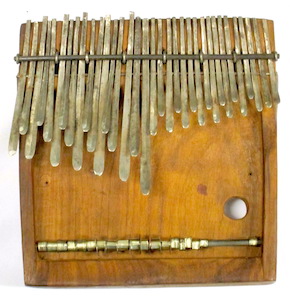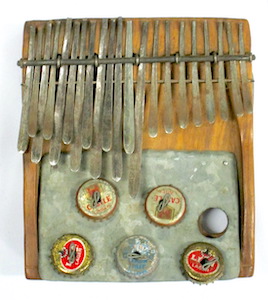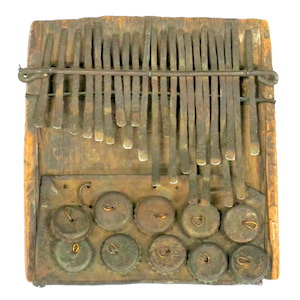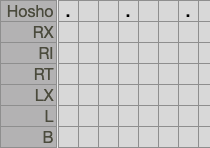Mbila dzamadeza
Table of contents
Introduction
This instrument class, along with its companion mbila dzamadeza (bass on right), represents the mbila dzamadeza type of mbira (lamellophone) from Vhembe district in Limpopo province, South Africa. It is recorded as an instrument played by both Venda and Lemba people, and is closely related to the mbira dzavadzimu. The instrument and part of its repertoire are believed to have been transmitted southwards in the wake of early Shona migrations and their role in the complex process of Venda ethnogenesis. Andrew Tracey explains that the name Mbila dzamadeza can be translated as "mbila of calabashes" and was used to differentiate it from the now extinct Venda xylophone known as mbila mutondo - "mbila of mutondo (wood)" made from Pterocarpus angolensis species (Mutondo/Mukwa/Kiaat). Mbila is the Tshivenda orthographic equivalent of mbira in chiShona. Mbila dzamadeza is also known informally as mbila deza or just deza / deze.
by James Munyai

by James Munyai

from Limpopo province (TIC 126)
Function and Repertoire
In Squaring the Circle (available from the author on request via SR), Klaus-Peter Brenner quotes John Blacking that [unlike the mbira dzavadzimu], "the Venda (and Lemba) mbila dzamadeza, being merely used for 'amusements etc.', has no such religious or political functions whatsoever. The description of this mbila from UW's Ethnomusicology Archives, however, states that "the Lemba people (one of several nations in Venda) also use this instrument for possession (not all nations of Venda do so)". Most of the currently documented repertoire comes from Andrew Tracey's field research in 1987. Many pieces can be assigned to two broad groupings:- Longer pieces with 48 pulse cycles that utilise systems of harmonic patterning described by Tracey as "the Shona mbira system / chord sequence" - 5th dyads (with sporadically added thirds) and their inversions typically arranged in 12-step progressions rising in thirds and fourths. Tracey calls this repertoire "songs in the older mbira style brought from the Shona".
- Shorter pieces with 12, 15, 16, 18, 24 and 32 pulse cycles, some of which utilise systems of harmonic patterning that Brenner describes as "the Venda Tshikona system" - 5th dyads (without occasional thirds) and their inversions typically arranged in 7-step progression regularly descending in seconds. This system of two descending lines in constant parallel movement is named after the ubiquitous Venda reedpipe dance.
Subtypes
Significantly more examples of the bass-on-left subtype are found in Tracey's fieldwork than bass-on-right, possibly indicating a greater prevalence. To keep the notation manageable and the user interface concise, they are treated as separate instrument classes and the suffix "(bass on left)" is omitted for the presumably more common class:- Mbila dzamadeza. The bass-on-left subtype. Its features include:
-
mid-range left manual that usually follows the same characteristic pattern (1-5-4-6-7)
as its equivalent on mbira dzavadzimu.
Only one of the about 15 bass-on-left instruments considered so far has an ascending scale, like the bass-on-right type. - lower left manual following the same pattern, resulting in octave pairs in the middle and bass manuals placed together, with the lower key of each pair positioned to the right.
- pitches 2 and 3 shifted to the extreme left of the lower left hand manual.
- occasionally a right hand low RT3 key, as on mbira dzavadzimu.
- extra right and left upper manuals.
-
mid-range left manual that usually follows the same characteristic pattern (1-5-4-6-7)
as its equivalent on mbira dzavadzimu.
- Mbila dzamadeza (bass on right).
Features of this subtype include:
- low RT3 key of some bass-on-left instrument dropped.
- both mid-range and low manuals arranged in sequential ascending order (1-2-3-4-5-6-7).
- one old example with extra upper manual(s).
Notations
There are two notations:- Pitch
- Pitch+Octaves
|

|
Key Overview
The table below shows all keys of the notation, from lowest to highest. Each row contains all possible keys for that playing area. Each column contains all keys of the same pitch. Not all instruments may have keys matching all these notes. Red notes are alias names for the same key, if it can be played with different fingers.| Hosho | . | ||||||||||||||||||||||||||
| RX | 5 | 6 | 7 | 1 | 2 | 3 | 4 | 5'' | |||||||||||||||||||
| RI | 3 | 4 | 5 | 6 | 7 | 1 | 2 | 3'' | 4'' | 5'' | |||||||||||||||||
| RT | 3/ | 1 | 2 | 3 | 4 | 5 | 6 | ||||||||||||||||||||
| LX | 1 | 2 | 3 | 4 | |||||||||||||||||||||||
| L | 1 | 3 | 4 | 5 | 6 | 7 | 1' | 2 | |||||||||||||||||||
| B | 1 | 2, | 3, | 4 | 5 | 6 | 7 | 2 | 3 | 6/ |
Aliases
The table below lists all alias keys. Row names are shown in black, cell content in red.| Key | Alias | Notes |
|---|---|---|
| RT3/ | L3 | RT3/ key played with the left thumb |
| RT3 | RI3 | RT3 key played with the index finger instead of the thumb |
| RI4 | RT4 | RI4 key played with the thumb instead of the index finger |
| RI5 | RT5 | RI5 key played with the thumb instead of the index finger |
| RI6 | RT6 | RI6 key played with the thumb instead of the index finger |
Key Overview
The table below shows all keys of the notation, from lowest to highest. Each row contains all possible keys for that playing area. Each column contains all keys of the same pitch. Not all instruments may have keys matching all these notes. Red notes are alias names for the same key, if it can be played with different fingers.| Hosho | . | ||||||||||||||||||||||||||
| RX | 5' | 6' | 7' | 1'' | 2'' | 3'' | 4'' | 5'' | |||||||||||||||||||
| RI | 3' | 4' | 5' | 6' | 7' | 1'' | 2'' | 3'' | 4'' | 5'' | |||||||||||||||||
| RT | 3 | 1' | 2' | 3' | 4' | 5' | 6' | ||||||||||||||||||||
| LX | 1' | 2' | 3' | 4' | |||||||||||||||||||||||
| L | 1 | 3 | 4 | 5 | 6 | 7 | 1' | 2' | |||||||||||||||||||
| B | 1, | 2, | 3, | 4, | 5, | 6, | 7, | 2 | 3 | 6 |
Aliases
The table below lists all alias keys. Row names are shown in black, cell content in red.| Key | Alias | Notes |
|---|---|---|
| RT3 | L3 | RT3 key played with the left thumb |
| RT3' | RI3' | RT3' key played with the index finger instead of the thumb |
| RI4' | RT4' | RI4' key played with the thumb instead of the index finger |
| RI5' | RT5' | RI5' key played with the thumb instead of the index finger |
| RI6' | RT6' | RI6' key played with the thumb instead of the index finger |